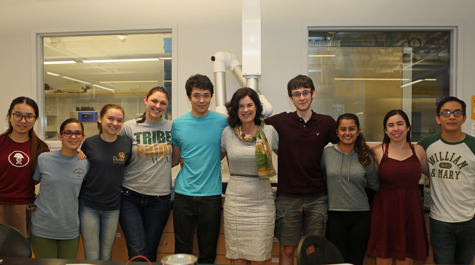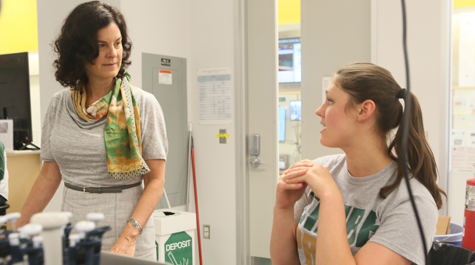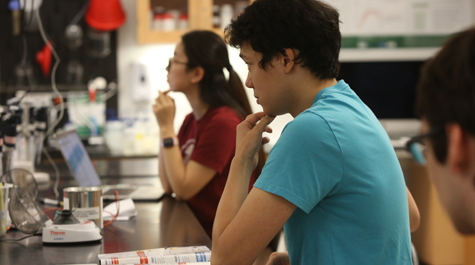W&M iGEM team decodes the signals of cells
The William & Mary iGEM team – the acronym stands for International Genetically Engineered Machine – is preparing to compete in the world’s largest synthetic biology competition for the fifth year in a row. Hundreds of student teams from major research institutions throughout the world will head to the iGEM Giant Jamboree on Oct. 24 in Boston. Each team’s project will be judged in a multi-faceted competition and the winner will take home what’s been called the World Cup of Science.
It’s a championship title the university has claimed before. A William & Mary team won the iGEM Grand Prize in 2015, was first runner-up last year and has medaled in all of the five competitions they’ve entered. This year, the team is aiming higher than a win at the Giant Jamboree. They have designed a kind of signal translator for cells. Once sufficiently tested in the lab, the invention could be a major contribution for the entire field, says Margaret Saha, Chancellor Professor of Biology at William & Mary.
“This year’s goal is exceptionally lofty, complicated, challenging and high-risk,” said Saha, who has been the university’s iGEM team advisor for the past five years. “We didn’t go for a tried-and-true project here. For all of synthetic biology, this would be extremely significant.”
In biological systems, cells communicate with one another and the environment using a series of complex signaling mechanisms, Saha explained. Those signals have both a frequency and amplitude, much like human speech or radio waves. While sometimes this signaling consists of small talk or noise, more frequently the cellular signals prompt a physiological response. This year’s team spent months of work on a circuit designed to decode those signals.
“The problem is that synthetic biologists do not fully understand the language of these signals,” Saha said. “That kind of dynamic, complex signaling is something synthetic biologists have not interfaced with because it’s really hard to interpret, to decode those signals. Our one-word, overall theme this year is ‘decode.’”
The team has designed a literal decoder, said team leader Ethan Jones ‘19. The decoder acts as an interface between natural circuit systems and synthetic ones. Natural circuits store signal information dynamically, based on how the strength of signals change over time, rather than their strength at a single specific point in time, he explained. Without a means of decoding those natural signals, it’s like trying to read a book before knowing the alphabet.
“It’s what natural systems do, because it lends a lot of complexity and structure,” Jones said, “but synthetic circuits aren’t built to deal with that. Synthetic biology wants to move into the area of being able to interact with natural systems. For example, if you want to build a cell that targets cancer, you have to be able to read cell signals. You need to actually be able to interpret those pieces of information.”
iGEM projects tend to promote collaborative and interdisciplinary work and this year is no exception. The team is made up of students majoring in biology, mathematics, applied mathematics, computer science and computational and applied mathematics and statistics (CAMS). In addition to Jones, the team members are Jessica Laury ’19, Tihn Son ’20, Lillian Parr ’21, Yashna Verma ’21, Stephanie Do ’21, Julia Urban ’21, Adam Oliver ’21, Hanmi Zou ’21, Chengwu Shen ’21 and Xiangyi Fang ’21.
Each iGEM project begins in the spring with the student team collaboratively deciding on the project they wish to pursue. This year’s project was partially inspired by last year’s project, controlling the speed of a circuit, Jones explained.
“As a group and as a school, we have been interested in this kind of foundational stuff for a while,” Jones said. “It’s very foundational, but very complex. We’re building a way to take these time-based input signals that cells give off, taking that dynamic information and translating it into an amplitude signal that synthetic circuits are used to dealing with. There’s a lot to this.”
Beyond the project itself, the iGEM competition strongly encourages each team to bring the science behind synthetic biology outside the lab and into their communities. Laury serves as the team’s public outreach coordinator. She says she is targeting all ages and demographics in her outreach, from retirement home residents, to entrepreneurs, elementary school students and public officials. She sees them all as stakeholders in the future of synthetic biology.
“The ultimate goal of our project is not just to say ‘it works,’” she said. “We need to make sure that synthetic biology projects are being implemented. When it comes to implementation, you have to have a company pick the project up or you may need policy to shift – and you need to have the general public not be afraid of the science.”
All that said, Laury is still hoping to bring something home from the competition.
“I have been very tired for a very long time,” she laughed, “so I’d really like it if we at least get nominated for a prize. If we don’t, my heart is gonna hurt.”
“But it’s hard to know going into it what will happen,” Jones added. “In the end, it’s about doing the work, not the actual end result. That result is just a proxy for having done the work and I feel we have.”
Saha agrees. She says the real grand prize is in the process.
“To me it’s the science that matters,” Saha said. “It’s a chance for the students to see how stunningly beautiful this field is to work in. That’s the opportunity.”
 Skip to main content
Skip to main content



